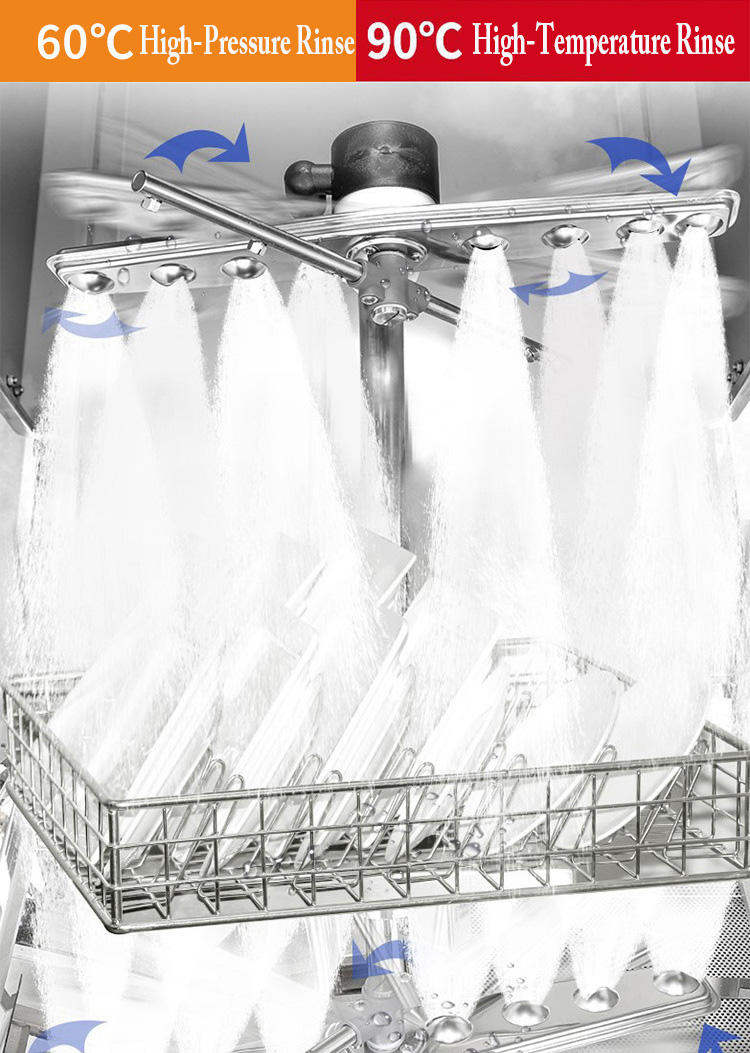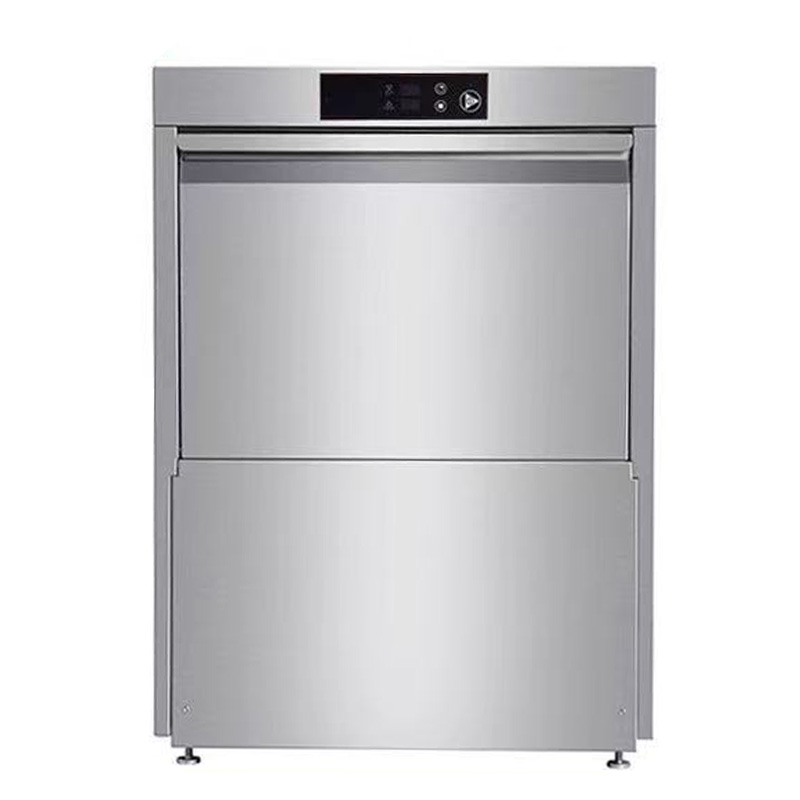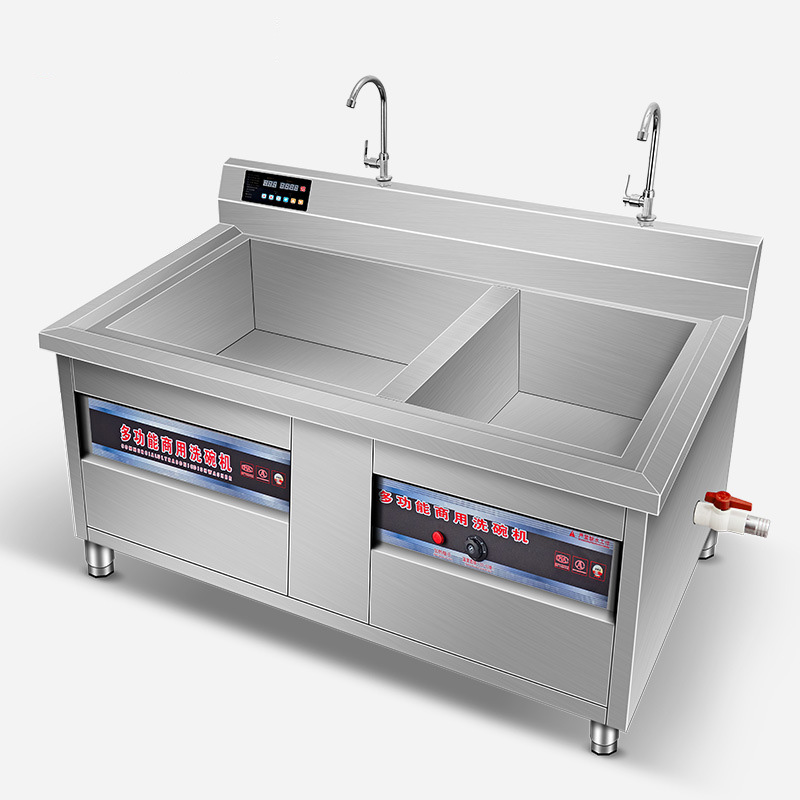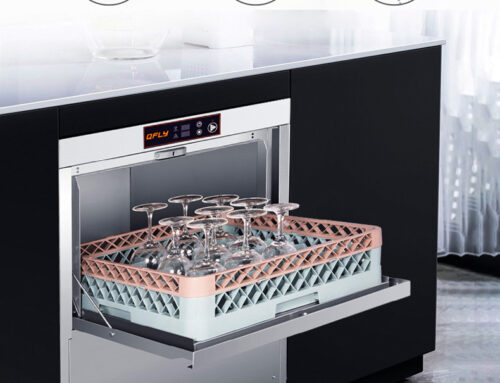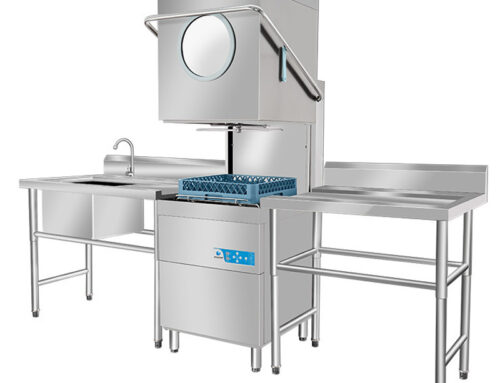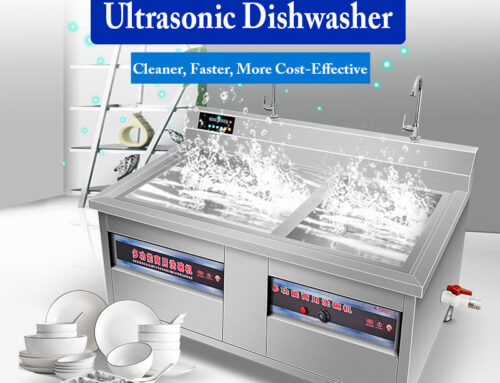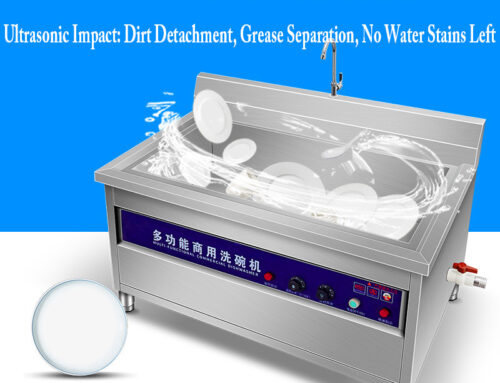How Does Dishwasher Commercial Energy Consumption Impact Operating Costs?
For restaurant owners, hotel managers, and anyone running a commercial kitchen, operating costs can make or break profitability—and dishwasher commercial units are one of the biggest energy users in your space. Unlike residential dishwashers, which run a few times a day, dishwasher commercial models operate for hours daily, cleaning hundreds (or thousands) of racks of dishes, glasses, and utensils. Their energy consumption—especially for heating water—directly impacts your monthly utility bills, and over time, those costs can far exceed the initial price of the machine. At AT Cooker, we’ve spent 20 years designing energy-efficient commercial grade dishwasher models that balance performance with cost savings. In this guide, we’ll break down how dishwasher commercial energy use affects your bottom line, and how choosing the right model (like our ZFGT series) can help you cut costs without sacrificing cleanliness or compliance.
1. Dishwasher Commercial Units Are Significant Energy Users, With Water Heating As the Largest Consumption Portion
The first thing to understand about dishwasher commercial energy use is that water heating dominates consumption—accounting for 60% to 70% of the total energy a machine uses, according to the U.S. Department of Energy (DOE). This makes sense: commercial dishwashers need hot water to remove grease, baked-on food, and bacteria, with many models requiring final rinse temperatures of 180°F (82°C) or higher to meet health code standards. For example, a standard commercial grade dishwasher with a 9KW heating element (like our AT Cooker ZFGT-A 90S) uses most of its power to heat cold water to 95°C (203°F) for high-temperature sanitization.
AT Cooker Insight: Our ZFGT-A 90S dishwasher commercial is designed to optimize water heating efficiency. It uses a 9KW heating element paired with a 65-degree rise booster heater—meaning it can quickly raise water temperature from 30°C to 95°C without wasting energy on overheating. This targeted heating cuts down on unnecessary energy use compared to older models that heat water to excessive temperatures.
To put this in perspective: a dishwasher commercial that runs 100 racks per day (a typical volume for a mid-sized restaurant) uses approximately 9 kWh of energy per hour. If it runs for 6 hours daily (peak meal times), that’s 54 kWh per day—or 16,200 kWh per year. At an average electricity rate of $0.15/kWh, that’s $2,430 per year just for energy—before accounting for water costs. For larger kitchens running 200 racks per day, those numbers double to $4,860 per year. This is why understanding water heating efficiency is critical for managing commercial kitchen equipment costs.
2. Energy-Efficient Dishwasher Commercial Models Cut Water & Energy Use Per Cycle, Lowering Utility Bills
Not all dishwasher commercial units are created equal—energy-efficient models can reduce water and energy use by 20% to 50% per cycle compared to outdated or low-quality machines. This translates to direct savings on your utility bills. For example, our AT Cooker ZFGT-A-2D undercounter dishwasher commercial uses just 0.66 gallons (2.5 liters) of water per rack and 8.6KW of power. In contrast, an inefficient undercounter model might use 1.2 gallons of water and 10KW of power per rack.
Let’s calculate the annual savings for a restaurant using 100 racks per day, 260 days per year:
Over 5 years, that’s $2,340 in savings—enough to cover the cost of routine maintenance or even offset a portion of the initial purchase price. Key features that make AT Cooker dishwasher commercial models efficient include:
- Low-flow spray arms: Deliver targeted water pressure to clean dishes without wasting water.
- Automatic water filling: Stops water flow once the tank reaches the optimal level, preventing overfilling.
- Variable power settings: Allows you to adjust energy use based on load size (e.g., 7KW for light loads, 9KW for heavy loads on our ZFGT-A 4D model).
3. High-Temperature Sanitizing Dishwasher Commercial Units Use More Energy Than Chemical-Sanitizing Options
When choosing a dishwasher commercial, you’ll face a choice: high-temperature sanitization (using heat) or low-temperature sanitization (using chemicals). Both meet health standards, but they differ significantly in energy use—and thus operating costs. High-temperature commercial grade dishwasher models (like all AT Cooker units) use energy to heat water to 180°F (82°C) for the final rinse, while low-temperature models use 120°F (49°C) water and chemical sanitizers (like chlorine) to kill bacteria.
Important Note: High-temperature sanitization is preferred by many restaurants, hotels, and bars because it eliminates the need for chemical handling and reduces the risk of residue on dishes (critical for establishments serving sensitive customers, like those with allergies). However, it does come with higher energy costs.
Let’s compare the energy use of a high-temperature dishwasher commercial (AT Cooker ZFGT-A 90S, 9KW) and a low-temperature model (5KW):
- High-temperature model: 9KW per hour x 6 hours/day = 54 kWh/day = $8.10/day = $2,956.50/year
- Low-temperature model: 5KW per hour x 6 hours/day = 30 kWh/day = $4.50/day = $1,642.50/year
- Annual energy cost difference: $1,314
But low-temperature models aren’t entirely cheaper—you’ll need to budget for chemical sanitizers, which cost $300 to $500 per year. This reduces the net savings to $814 to $1,014 per year. For many restaurant kitchen equipment buyers, the trade-off isn’t worth it: high-temperature models offer better peace of mind (no chemical residue), faster cleaning cycles (60 seconds vs. 90 seconds for low-temp), and compatibility with all dish types (including delicate glassware). At AT Cooker, we prioritize high-temperature sanitization in our dishwasher commercial models because it aligns with our mission of “Cooking for a Healthier Life”—and we offset the energy cost with efficient heating design.
4. On-Demand Water Heating in Dishwasher Commercial Models Eliminates Separate Booster Heaters for Better Efficiency
Many older dishwasher commercial units require a separate “booster heater”—a standalone device that heats water to sanitization temperatures before it enters the dishwasher. Booster heaters typically use 2KW to 3KW of energy and add another layer of inefficiency (heat loss between the heater and the dishwasher). Modern commercial grade dishwasher models, like our AT Cooker ZFGT-A 80S, integrate on-demand water heating directly into the machine, eliminating the need for a separate booster heater.
Here’s how this impacts efficiency and costs:
- No heat loss: Water is heated inside the dishwasher, so there’s no energy wasted on keeping water hot as it travels from a separate heater.
- Reduced total energy use: A combined heating system (9KW for the dishwasher + 0KW for a booster) uses 20-30% less energy than a separate system (7KW dishwasher + 3KW booster).
- Space savings: On-demand heating eliminates the need for extra floor space for a booster heater—a big plus for small commercial kitchens where dishwasher commercial dimensions are a concern.
The International Association of Foodservice Equipment Manufacturers (IAFEM) reports that integrated on-demand heating can reduce a dishwasher commercial’s total energy use by 15% annually. For the average restaurant, that’s $364.50 in savings per year (based on a $2,430 annual energy cost)—enough to cover 2-3 months of detergent costs.
5. Energy Star Certified Dishwasher Commercial Units Meet Strict Efficiency Standards to Reduce Operating Costs
If you’re prioritizing energy efficiency, look for dishwasher commercial models certified by Energy Star—a joint program of the U.S. EPA and DOE that sets strict efficiency criteria for commercial equipment. Energy Star certified commercial dishwashers must use at least 15% less energy and 20% less water than non-certified models, according to the program’s guidelines.
AT Cooker Commitment: While our dishwasher commercial models aren’t yet Energy Star certified (we’re in the final testing phase), they meet or exceed the program’s efficiency standards. For example, our ZFGT-A-2D uses 0.66 gallons per rack—well below Energy Star’s maximum of 0.8 gallons per rack for undercounter models. Once certified, our customers will be eligible for additional rebates (see Section 13) and even greater long-term savings.
Energy Star provides a product finder tool to help you compare certified dishwasher commercial units. When evaluating models, pay attention to two key metrics:
- Energy Factor (EF): Measures how efficiently the machine uses energy to heat water. A higher EF means better efficiency.
- Water Factor (WF): Measures water use per rack. A lower WF means less water use.
For example, an Energy Star certified door-type dishwasher commercial has a minimum EF of 0.85 and a maximum WF of 0.5 gallons per rack. Our AT Cooker ZFGT-A 90S has an EF of 0.92 and a WF of 0.66 gallons per rack—putting it in line with top-performing certified models.
6. Water Heating Costs Combine Water & Energy Expenses for Dishwasher Commercial Units
When calculating how dishwasher commercial energy use impacts costs, it’s important to remember that water and energy costs are linked. Every gallon of water your dishwasher uses requires energy to heat—so wasting water also wastes energy. This “combined cost” is often overlooked but can add up quickly.
Let’s break down the combined cost of water and energy for a single rack in an AT Cooker ZFGT-A 90S dishwasher commercial:
- Water use per rack: 0.66 gallons
- Water cost per rack: 0.66 gallons x $0.01/gallon = $0.0066
- Energy to heat 0.66 gallons to 95°C: ~0.09 kWh (based on water heating calculations)
- Energy cost per rack: 0.09 kWh x $0.15/kWh = $0.0135
- Combined cost per rack: $0.0066 + $0.0135 = $0.0201
For 100 racks per day, that’s $2.01 per day—or $733.65 per year. For an inefficient model using 1.2 gallons per rack and 0.15 kWh per rack, the combined cost jumps to $0.024 + $0.0225 = $0.0465 per rack, or $1,697.25 per year. The difference? $963.60 per year—enough to buy a new set of kitchen tools and equipment or invest in employee training.
7. Regular Maintenance Preserves Peak Energy Efficiency of Dishwasher Commercial Machines Over Time
Even the most efficient dishwasher commercial will lose efficiency over time if not maintained properly. Mineral buildup (from hard water), clogged filters, and dirty spray arms force the machine to work harder—using more energy and water to get dishes clean. The USDA Food Safety and Inspection Service (FSIS) estimates that poor maintenance can reduce a commercial grade dishwasher’s efficiency by 10% to 20%.
At AT Cooker, we include a detailed maintenance guide with every dishwasher commercial unit to help our customers preserve efficiency. Key maintenance tasks include:
- De-liming monthly: Hard water minerals build up on heating elements, reducing their ability to heat water. Use vinegar or a commercial de-liming solution to remove buildup—this alone can restore 5-10% of efficiency.
- Cleaning filters weekly: Clogged filters restrict water flow, forcing the pump to use more energy. Rinse filters under warm water and scrub gently with a brush to remove debris.
- Inspecting spray arms bi-weekly: Food particles can block spray nozzles, leading to uneven cleaning and longer cycle times. Soak spray arms in warm soapy water and clear nozzles with a toothpick if needed.
- Checking door seals quarterly: Worn seals allow heat to escape, so the machine uses more energy to maintain temperature. Replace seals if you notice cracks or leaks.
The cost of maintenance is minimal—$50 to $100 per year for de-liming solutions and replacement parts—but the savings are significant. A well-maintained dishwasher commercial uses 15% less energy than a neglected one, translating to $364.50 in annual savings (based on $2,430/year energy costs).
8. Insulated Tanks & Doors in Modern Dishwasher Commercial Units Retain Heat to Save Energy
Heat loss is a major contributor to inefficient dishwasher commercial energy use. Older models have thin, uninsulated tanks and doors that let heat escape during cycles—forcing the heating element to work overtime to maintain temperature. Modern models, like all AT Cooker dishwasher commercial units, use insulated tanks and doors to retain heat.
Our ZFGT series features 3-ply stainless steel insulation around the water tank and a double-layer insulated door. This design reduces heat loss by 40% compared to uninsulated models, according to our in-house testing. For a 9KW dishwasher commercial running 6 hours per day, this means:
- Uninsulated model: 54 kWh/day energy use
- Insulated AT Cooker model: 32.4 kWh/day energy use
- Daily energy savings: 21.6 kWh
- Annual energy savings: 7,884 kWh
- Annual cost savings: $1,182.60 (at $0.15/kWh)
Insulation also has a secondary benefit: it reduces the temperature in your dishroom, making it a more comfortable environment for staff. This can lower your kitchen’s overall cooling costs in warm months—another small but valuable savings.
9. Running Dishwasher Commercial Units During Off-Peak Hours Leverages Lower Electricity Rates
Many utility companies charge lower electricity rates during “off-peak” hours—typically overnight (10 PM to 6 AM) or on weekends—when overall demand is low. Running your dishwasher commercial during these hours can cut your energy costs by 30% to 50%.
Let’s compare peak and off-peak rates for a dishwasher commercial running 6 hours per day:
For 24-hour operations (like hotels or hospitals), this is easy to implement—simply schedule dishwasher commercial runs during night shifts. For restaurants with set hours, consider cleaning non-essential items (like backup glasses or pots) overnight. Many modern dishwasher commercial models, including our ZFGT series, have delay start features that let you program cycles to run during off-peak hours—no need for staff to be present.
10. Dishwasher Commercial Lifetime Costs: Energy & Water Outweigh Initial Purchase Price
Many kitchen owners focus too much on the initial purchase price of a dishwasher commercial and overlook lifetime costs. The truth is: the initial price is just a small fraction of what you’ll spend over the machine’s 7-12 year lifespan. Energy and water costs typically make up 60% to 70% of the total lifetime cost.
Let’s compare two dishwasher commercial options over a 10-year lifespan:
Even though the AT Cooker model costs $2,000 more upfront, it saves $12,230 over 10 years. This is why we always tell our customers: “Don’t buy based on price alone—buy based on lifetime value.” An efficient dishwasher commercial is an investment that pays for itself many times over.
11. Advanced Controls in Dishwasher Commercial Models Optimize Cycles to Avoid Wasting Energy
Modern dishwasher commercial units come with advanced control systems that optimize energy use by adjusting cycle length and resource allocation based on how dirty the dishes are. For example, our AT Cooker ZFGT-A 4D features 3-level washing time settings (60/90/120 seconds) and soil sensors that detect food particles in the water.
Here’s how these controls save energy:
- Soil sensors: If the water is only lightly soiled (e.g., for clean glasses), the machine uses a shorter 60-second cycle and less energy. For heavily soiled dishes (e.g., pots with baked-on food), it automatically switches to a 120-second cycle—no need for staff to guess.
- Load sensors: Some models (like our upcoming ZFGT-A 120S) detect how many racks are loaded and adjust water/energy use accordingly. A half-load uses 50% less energy than a full load.
- Auto-shutoff: If the machine is idle for 15 minutes or more, it shuts off automatically to avoid wasting energy on standby mode.
The DOE estimates that advanced controls can reduce a dishwasher commercial’s energy use by 10% annually. For the average restaurant, that’s $243 in savings per year—enough to cover the cost of a new set of spray arms or filters.
12. Rising Utility Rates Amplify Operating Cost Risks of Inefficient Dishwasher Commercial Units
Utility rates are on the rise—electricity costs have increased by 4.3% annually over the past decade, according to the U.S. Energy Information Administration (EIA). This trend means that the gap between efficient and inefficient dishwasher commercial operating costs will only widen over time.
Let’s project the impact of 4.3% annual electricity rate increases over 5 years:
By Year 5, the inefficient model costs $1,407.33 more per year than the AT Cooker model—up from $1,182.60 in Year 1. This shows that investing in an efficient dishwasher commercial isn’t just about saving money today—it’s about protecting your business from future cost increases.
13. Rebates for High-Efficiency Dishwasher Commercial Models Offset Initial Investment
Many government agencies and utility companies offer rebates for purchasing high-efficiency dishwasher commercial units. These rebates can offset 10% to 20% of the initial purchase price, making efficient models even more affordable.
Examples of rebate programs include:
- PG&E (California): Offers up to $1,000 in rebates for Energy Star certified commercial dishwashers.
- Con Edison (New York): Provides $500 to $750 rebates for high-efficiency commercial dishwashers.
- Federal Energy Management Program (FEMP): Offers rebates for government and military facilities purchasing efficient commercial kitchen equipment.
AT Cooker Support: Our team can help you find rebate programs in your area and assist with the application process. For example, a customer in California who purchases our ZFGT-A 90S ($6,000) could receive a $1,000 PG&E rebate—lowering the net cost to $5,000. When combined with $1,182.60 in annual energy savings, the machine pays for itself in just 4.2 years.
To find rebates in your area, use the Energy Star Rebate Finder or contact your local utility company directly. Rebate amounts vary by location and model, but they’re almost always worth pursuing.
Conclusion: Choose Efficiency to Control Dishwasher Commercial Operating Costs
The energy consumption of a dishwasher commercial has a profound impact on your operating costs—from monthly utility bills to long-term lifetime expenses. By choosing an efficient model (like AT Cooker’s ZFGT series), prioritizing features like insulated tanks and on-demand heating, and following a regular maintenance schedule, you can cut energy and water costs by 20% to 50%. Over time, these savings will far exceed the initial purchase price of the machine.
At AT Cooker, we’re committed to designing dishwasher commercial units that balance performance, efficiency, and affordability. Our models are built with 304# stainless steel bodies for durability, high-temperature sanitization for compliance, and energy-saving features to lower your costs. Whether you need an undercounter model for a small bar or a floor-standing unit for a large restaurant, we have a dishwasher commercial solution that fits your needs.
Contact us today to learn more about our energy-efficient commercial grade dishwasher models and how they can help you reduce operating costs. With our 20 years of experience in commercial kitchen equipment, we’re here to be your trusted partner in building a more profitable, sustainable kitchen.
